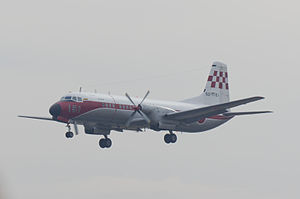YS-11
| YS-11 | |
|---|---|
 |
|
| A Japan Air Self-Defense Force YS-11 (2011) | |
| Role | Turboprop Airliner |
| Manufacturer | Nihon Aircraft Manufacturing Corporation |
| First flight | August 30, 1962 |
| Introduction | March 30, 1965, for All Nippon Airways (first passenger flight with Japan Air Commuter in 1965) |
| Status | In limited service |
| Produced | 1962–1974 |
| Number built | 182 |
The NAMC YS-11 is a turboprop airliner built by a Japanese consortium, the Nihon Aircraft Manufacturing Corporation. The program was initiated by the Ministry of International Trade and Industry in 1954, the aircraft was rolled out in 1962, and production ceased in 1974.
In the mid-to-late 1950s, the Japanese Ministry of International Trade and Industry identified a requirement for a short-haul airliner to replace Douglas DC-3s flying on Japan's domestic routes, and encouraged companies in Japan's aircraft industry to collaborate to develop and produce the new airliner. A joint venture between Mitsubishi Heavy Industries, Kawasaki Heavy Industries, Fuji Heavy Industries (now better known as the parent company of automobile manufacturer Subaru), Shin Meiwa, Showa Aircraft Industry Company and Japan Aircraft Industry Company was set up in 1957, being formalised as the Nihon Aeroplane Manufacturing Company (NAMC) in 1959.
NAMC designed a low-winged twin-turboprop monoplane seating 60 passengers. Jiro Horikoshi, the designer of the Mitsubishi A6M Zero fighter was involved in designing it. Although the aircraft was mainly designed and manufactured in Japan, the engines were built by Rolls-Royce, with the 2,275 kW (3,050 ehp) Rolls-Royce Dart RDa.10/1 being selected for the new aircraft. Electronic equipment, avionics, mechanical and fuselage components were supplied either by Japanese companies or foreign suppliers during the YS-11's production lifetime. The twin-engined YS-11 delivered similar operational performance to the four-engined Vickers Viscount, and had 50% more capacity than the similarly configured Fokker F27 Friendship.
...
Wikipedia
